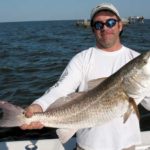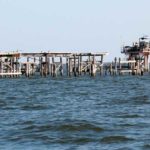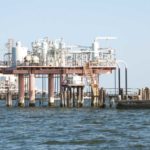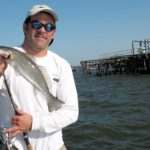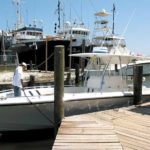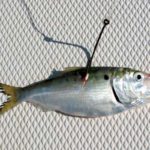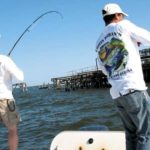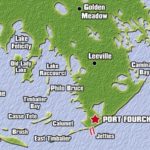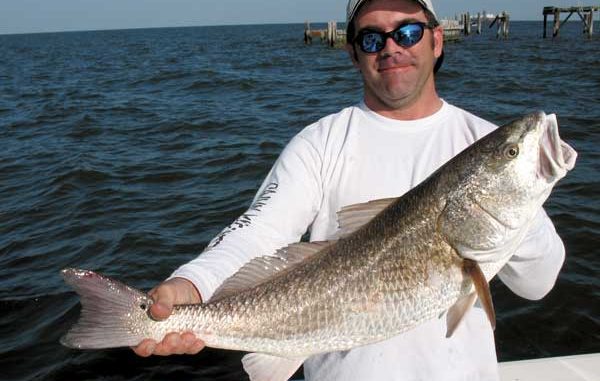
Oil, gas, new construction and highways — and oh yes, trout, reds, sheepshead and drum.
I have to admit that my recent drive down Highway 1 and then along Fourchon Road was eye-opening.I was on my way to Chris Moran’s Belle Pass Marina, and trying to remember the last time I fished out of it. I know it was before Katrina, and back before Capt. Charlie Hardison passed on, and things had sure changed. Rows of new supply buildings lined the roads, and a constant flow of supply boats streamed in and out. The new highway being constructed will make the commute of over 10,000 vehicles a day safer and faster, and provide an elevated roadway to the oft-flooded Highway 1 and better egress when evacuations are necessary.
Did you know that Port Fourchon services half of the drilling rigs operating in the entire Gulf of Mexico? Did you know that it services over 75 percent of the deepwater oil production? Did you know that up to 30 percent of our domestic oil supply comes through Fourchon? Did you know that it is Louisiana’s only directly on-the-Gulf port?
Well, now you know. It is a bustling, busy and very productive place.
Right now, the 17-mile stretch of road between Golden Meadow and Fourchon is sinking and so prone to flooding that a strong high tide can inundate the road and close it to vehicular traffic. The corridor is so vital to America’s oil and gas supply that a $1.5 billion highway construction project was proposed as a remedy. A new, high-rise, fixed bridge over Bayou Lafourche at Leeville is already well under way, and that phase of the project is scheduled for completion next year. Eventually the plan is to build a 47-mile stretch of highway from Highway 90 at Raceland all the way to Fourchon.
Like I said, there is a whole lot of activity going on down the bayou.
And did I mention fishing? In this department, too, Fourchon is flourishing. Located just 9 or 10 miles before Grand Isle, Fourchon is sandwiched between some of the finest fishing areas anywhere. It’s situated in between Leeville, Cocodrie and Grand Isle, and is within reach of Golden Meadow and even Lafitte. Its immediate access to the Gulf of Mexico makes it an attractive port to numerous offshore charter boats, and because it’s such a short jump from Fourchon into Timbalier Bay, it’s appealing to coastal anglers as well.
My game plan was to do some trout and redfish fishing with Moran, a plan that the weather had already thwarted on three previous occasions. But this time, it looked like we had a green light. The persistent winds had finally begun to lay, the water in the bay began to show some signs of clarity and the baitfish, shrimp and birds were showing up all over. It was time to make our move and try to get into some action.
I arrived at the Belle Pass Marina just as Moran tied his 34-foot center console Venture off at the dock. The bait well was loaded with live shrimp, cocahoes, croakers and pogies, and Moran said if we didn’t catch anything today, it wouldn’t be for lack of bait.
Several other anglers who were supposed to join us that morning washed out at the last minute, so it would be just three of us — Chris, me and Joshua Billiot, Moran’s deckhand — fishing that day out of the 34-foot boat.
I told Moran this would be a record-breaking day in that I’d never fished for trout out of so large a boat. He said several other captains were fishing for trout in similar boats out of other ports, and they found the advantages to outweigh the disadvantages.
“This is obviously not a wintertime boat to creep around in the marsh with,” Moran said. “But for fishing in the spring and summer in the big bays, it works out great. For one thing, I can take a party of five or six anglers aboard this boat, and they can all fish very comfortably without crowding each other. And the big enclosed head under the console is a nice feature as well.”
I know for certain that any boat with an enclosed head will be a hit with our female counterparts. For some reason, they tend to find that a far better option than a bucket or hanging over the side.
Twin 250 Yamahas moved us quickly through Devil’s Pass, and Moran pointed the bow toward Northwest Island, one of many such islands in Timbalier Bay.
“Right now is a great time to fish all of these islands,” Moran said. “Philo Bruce, Brush, Casse Tete, Calumet, the Fornations, West Timbalier, East Timbalier — all over,” he said. “Trout and redfish will hang out along the sandbars, on the beach, over reefs and around rocks. Depending on what the bottom is like, we’ll cast live baits on a sliding sinker rig, under a cork or freelined.”
We chewed mud as we approached one end of the island, and Moran commented on the low water. The tide was supposed to be coming in, but so far showed no inclination to move in either direction. I was surprised when Moran said the big boat only drew 22 inches of water, which I don’t think is bad for such a big rig. But rather than egg-beat our way through the shallow bottom, Moran changed course, and we headed for the nearby rock wall at Northwest Island.
The rocks in this area, much like the rocks along East Timbalier Island, are mostly submerged. The huge underwater stones definitely pose a navigation hazard to boaters who are unaware of their presence, but they provide excellent structure for baitfish and the critters that eat them, and for us critters who eat the critters, it’s a great place to cast a bait. Moran said these rocks will produce some great mixed catches of fish throughout the month.
“Reds, drum, sheepshead and trout — all right here, all summer long,” he said.
The water clarity that morning was not too good, probably the result of several previous days of stiff winds. But we cast our baits and gave the rock wall a few ticks of the watch.
“I only give a spot 10 minutes or so to produce some hits,” Moran said. “Think about it: When I bring out a charter in this boat, we generally have six people fishing, all at the same time, and that is a lot of bait in the water. When you put that much live bait in the water if there are fish anywhere around, they’ll hit it. If 10 minutes pass without any action, I’m gone. The fish are out here; you just move until you find them.”
All morning long, we saw flocks of birds dive-bombing the surface, undoubtedly chasing their favorite early summer snack — shrimp. And any angler worth his salt knows that when the birds are dive-bombing from above, the specks are torpedoing from below. It’s got to be heck to be at the bottom of the food chain.
The temptation to see what was under all those birds became too hard to resist, and Moran pointed the bow upcurrent of a large, feeding flock. As we drifted near the frenzy, we started getting hits on every cast. Specks! Three out of four were throwbacks, but we were able to stay on them awhile and put quite a few fish in the box.
“You see how crazy the action is right now with only three of us fishing and everybody hooking up?” Moran asked. “Imagine six people all hooked up at the same time. Imagine six people all hooked up with big reds. It happens out here all the time.”
After the boat drifted through the swarm, the birds went off about 70 yards to dive-bomb over another school. I love fishing under the birds, and I don’t even mind culling out the schoolies as long as I’m catching some keepers along with them.
But we had bigger plans for the day, and Moran headed us toward a nice-sized rig to see if we could find some larger fish.
There are numerous rigs scattered throughout the big bay, and most of them hold fish. Live baits on a sliding-sinker rig seemed to be the best choice, but the bottom debris likes to eat sinkers, so freelining or using a small split-shot about 6 inches above the bait proved to be the best bet.
We added a few more trout to the box, along with a few sheepshead and a redfish, before Billiot pulled the anchor, and we moved to another spot.
“This is how you fish out here,” Moran said. “You move until you find them. Right now everything is scattered, the water is cloudy and the tide is virtually non-existent. Usually by now we would have struck a good school and had plenty of nice trout in the boat. We’re having to work for them today.”
We wound up fishing several more islands, a couple rigs, another flock or two of birds and the jetty at Belle Pass before calling it a day. In the process, we caught specks, reds, drum and sheepshead at the rigs and islands; trout and giant gafftops under the birds; and we had a head-on collision with a school of huge redfish at the jetty.
We actually caught bull reds at several of the rigs and at the rocks on East Timbalier Island, but the fish at the jetties were thick and voracious. For awhile there, we caught one on virtually every cast. They stretched our lines and continually broke us off, but we couldn’t resist retying and casting again to catch another one.
Both sides of the jetty seemed to be loaded with fish, but the seas had built up to solid 3-footers and the constant flow of vessels through the pass made us decide to stay put. But I’m of the persuasion that all an angler has to do right now is work along those rocks, and you’ll catch all the fish you can keep.
Capt. Chris Moran can be reached at 985-396-2442.
